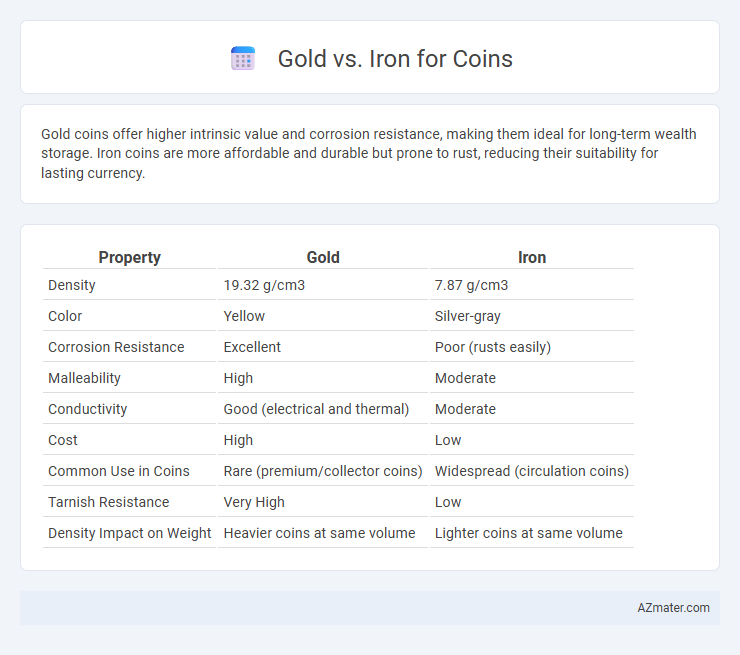Gold coins offer higher intrinsic value and corrosion resistance, making them ideal for long-term wealth storage. Iron coins are more affordable and durable but prone to rust, reducing their suitability for lasting currency.
Table of Comparison
| Property | Gold | Iron |
|---|---|---|
| Density | 19.32 g/cm3 | 7.87 g/cm3 |
| Color | Yellow | Silver-gray |
| Corrosion Resistance | Excellent | Poor (rusts easily) |
| Malleability | High | Moderate |
| Conductivity | Good (electrical and thermal) | Moderate |
| Cost | High | Low |
| Common Use in Coins | Rare (premium/collector coins) | Widespread (circulation coins) |
| Tarnish Resistance | Very High | Low |
| Density Impact on Weight | Heavier coins at same volume | Lighter coins at same volume |
Historical Overview: Gold and Iron in Coinage
Gold has been prized for coinage since ancient civilizations like Lydia around 600 BCE, valued for its rarity, durability, and resistance to corrosion, making it a symbol of wealth and stability. Iron, while abundant and used in various tools and weaponry, rarely served as a primary material for coins due to its susceptibility to rust and lack of intrinsic value. Historical coinage predominantly favored gold for high-value transactions and iron's use was limited to lower denominations or emergency coinage during shortages.
Material Properties: Gold vs Iron in Minting
Gold offers superior corrosion resistance and malleability, making it ideal for detailed coin designs and long-lasting durability. Iron, while more abundant and cost-effective, is prone to rust and requires protective coatings to prevent degradation. The high density of gold also provides a heavier, premium feel compared to iron coins, enhancing perceived value.
Durability and Longevity of Gold and Iron Coins
Gold coins exhibit superior durability and longevity compared to iron coins due to gold's resistance to corrosion, tarnish, and oxidation. Iron coins are prone to rust and degradation over time, especially in humid or acidic environments, which significantly reduces their lifespan. The inherent stability of gold ensures that coins made from it retain their physical integrity and aesthetic appeal for centuries, making gold the preferred choice for lasting coinage.
Value Retention: Gold Coins vs Iron Coins
Gold coins exhibit superior value retention compared to iron coins due to their intrinsic rarity, resistance to corrosion, and long-established status as a global store of wealth. Iron coins are prone to rust, degradation, and significant depreciation over time, which diminishes their long-term investment potential. Historical data and market trends consistently highlight gold coins as a reliable hedge against inflation and currency devaluation, ensuring sustained purchasing power across economic cycles.
Economic Impacts of Gold and Iron Currency
Gold currency historically maintained high economic stability due to its intrinsic value, scarcity, and resistance to corrosion, which fostered trust and long-term wealth preservation in global markets. Conversely, iron currency, being more abundant and prone to corrosion, often led to lower market confidence and inflationary pressures, limiting its effectiveness in large-scale trade and wealth storage. The economic impacts of gold coinage include enhanced monetary stability and facilitation of international trade, while iron currency typically resulted in localized use and higher volatility within economies.
Corrosion and Tarnish: How Gold and Iron Age
Gold exhibits exceptional resistance to corrosion and tarnish due to its inert chemical properties, maintaining its luster over centuries without oxidizing or developing patina. Iron, composed primarily of iron atoms susceptible to oxidation, readily forms rust when exposed to moisture and oxygen, leading to surface deterioration and structural weakening over time. This stark contrast makes gold a preferred metal for long-lasting coins, while iron coins require protective coatings to mitigate aging and corrosion effects.
Rarity and Availability: Gold vs Iron Resources
Gold is significantly rarer than iron due to its limited abundance in the Earth's crust, estimated at about 0.004 parts per million compared to iron's 50,000 parts per million. This scarcity makes gold a preferred material for coins with high intrinsic value, as it is harder to mine and refine, enhancing its exclusivity. Iron's widespread availability and lower rarity result in its use primarily for industrial purposes rather than as a precious metal in coinage.
Symbolism and Cultural Significance of Gold and Iron Coins
Gold coins symbolize wealth, power, and divine favor, historically serving as embodiments of prosperity and status in many cultures worldwide. Iron coins, often associated with durability, resilience, and common economy, reflect practicality and the everyday lives of ordinary citizens in ancient and medieval societies. The cultural significance of gold versus iron coins highlights a contrast between luxury and utility, with gold representing elite prestige and iron symbolizing grounded, accessible value.
Modern Uses: Gold and Iron in Contemporary Coinage
Gold remains a preferred material in modern coinage for bullion and commemorative coins due to its intrinsic value, resistance to corrosion, and appeal among investors. Iron, by contrast, is rarely used in contemporary coins because it oxidizes easily, making it unsuitable for long-term preservation and aesthetic purposes. Modern circulation coins typically favor durable alloys like cupronickel or steel coated with other metals rather than pure iron.
Investment Perspectives: Choosing Between Gold and Iron Coins
Gold coins offer a stable investment with high liquidity and long-term value preservation due to gold's intrinsic rarity and global demand. Iron coins, while historically significant, lack the same investment appeal because iron is prone to corrosion and has minimal intrinsic value compared to precious metals. Investors prioritize gold coins for portfolio diversification, inflation hedging, and potential capital appreciation over the typically low-value, collectible nature of iron coins.

Infographic: Gold vs Iron for Coin
 azmater.com
azmater.com